In the whole of Russian history, there have been a mere handful of men to earn the nickname “the great”. But there has only ever been one woman. Catherine the Great was an empress who defied both her circumstances and the opinions of those around her to shape an entire era. Born into a minor German family in the first half of the 18th Century, she found herself thrust into the spotlight when she married Peter III of Russia aged only 16. But rather than being a pushover, Catherine used her new position to grab the imperial crown for herself.
Empress of Russia from 1762 to 1796, Catherine’s reign spanned global conflicts and revolutions, uprisings and royal assassinations. But she never lost sight of her goal: to forge a modern Russia from the ideals of the Enlightenment. A philosopher empress to some, an amoral, sex-obsessed harlot to others, this is the life of one of Russia’s greatest rulers.
An Unlikely Ruler
To say Catherine the Great’s path to the throne was an unlikely one is a little bit like saying Siberia gets a bit chilly in winter. At the moment she was born Sophie Friederike Auguste on May 2, 1729, the likelihood of Catherine becoming ruler of Russia was up there with me one day becoming emperor of Japan.
By the way Tokyo, if the new guy doesn’t work out, do give me a call.
Young Sophie – who we’re just gonna start calling Catherine right now to avoid confusion – didn’t have a drop of Russian blood in her. Rather, her father was a minor German prince, while her mother Joanna was a slightly-less minor aristocrat who had ideas above her station. And those ideas emphatically did not involve having a daughter.
From the moment Joanna discovered she’d pumped out not a useful male heir but a useless girl, she treated Catherine less like a human and more like a receptacle for all her disappointments. Joanna called her daughter useless, ugly, told her she was worthless. It probably didn’t help that Joanna herself was a mere 17 when she became a mother, and that her arranged marriage to Catherine’s much-older dad hadn’t exactly been a fairytale.
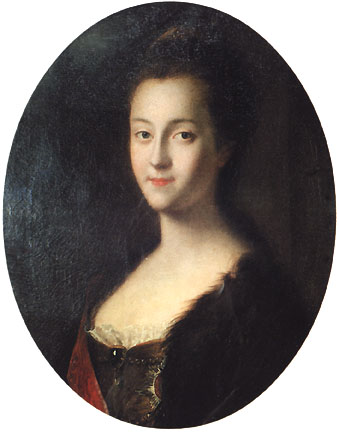
It probably also didn’t help that Catherine went out of her way to confirm Joanna’s fears. She was clumsy. Accident prone. There’s a story that she once managed to dislocate her spine just by sneezing. Yet, even amid all these excursions into klutz territory, it was clear there was something more to Catherine than Joanna gave her credit for. When she was just four, she met the future king Frederick the Great. Told to kiss his hem as a mark of respect, she instead demanded the royal bow down to her so she could reach.
Frederick was so tickled by this that he never forgot the confident young girl.
Yet it would be another encounter that really defined Catherine’s childhood. A grandson of Peter the Great, Peter Ulrich was a mere 11 when he and 10-year old Catherine met, and about as far from his famous grandfather as can be imagined. While Peter the Great had ruled Russia, Peter Ulrich was German through and through. While Peter the Great had been a dashing warrior-reformer, his grandson was sickly and neurotic.

He was also deeply damaged.
Left in the care of a sadistic tutor, Peter Ulrich had spent his life being beaten, tortured, and humiliated by the adult meant to care for him. He was made to stand at the dining table, a picture of a donkey hung around his neck. Made to endure savage whippings for the tiniest infraction. As our video unfolds today, Peter Ulrich is going to take a role best essentially as the villain.
As he does so, just remember that the abuse he suffered as a child is at least partly to blame.
Despite their differences, Catherine and Peter hit it off during their first meeting, becoming not exactly friends, but maybe friendly acquaintances. Still, there’s no way Catherine could’ve known just what fate had in store for them. No way she could’ve know that this sickly, troubled lad was the future emperor she was destined to overthrow.
The Empire of Ice
On the frozen night of December 5, 1741, a group of guards marched into the bedchamber of Russia’s infant emperor Ivan VI and arrested him and his mother, Anna Leopoldovna. By the morning of December 6, both mother and child had been locked away and Moscow had a new ruler. The daughter of Peter the Great, Empress Elizabeth was the Imelda Macros of the 18th Century, a woman obsessed with clothes, spectacle, and living the good life on the state budget.
She surrounded herself with pomp and fawning courtiers, and forbade anyone but herself from wearing pink. But for our story today, the defining feature of Elizabeth was that she was childless. Not long after her coup against Ivan, Elizabeth decided to bag herself an heir by inviting Peter Ulrich to Moscow to be her son.
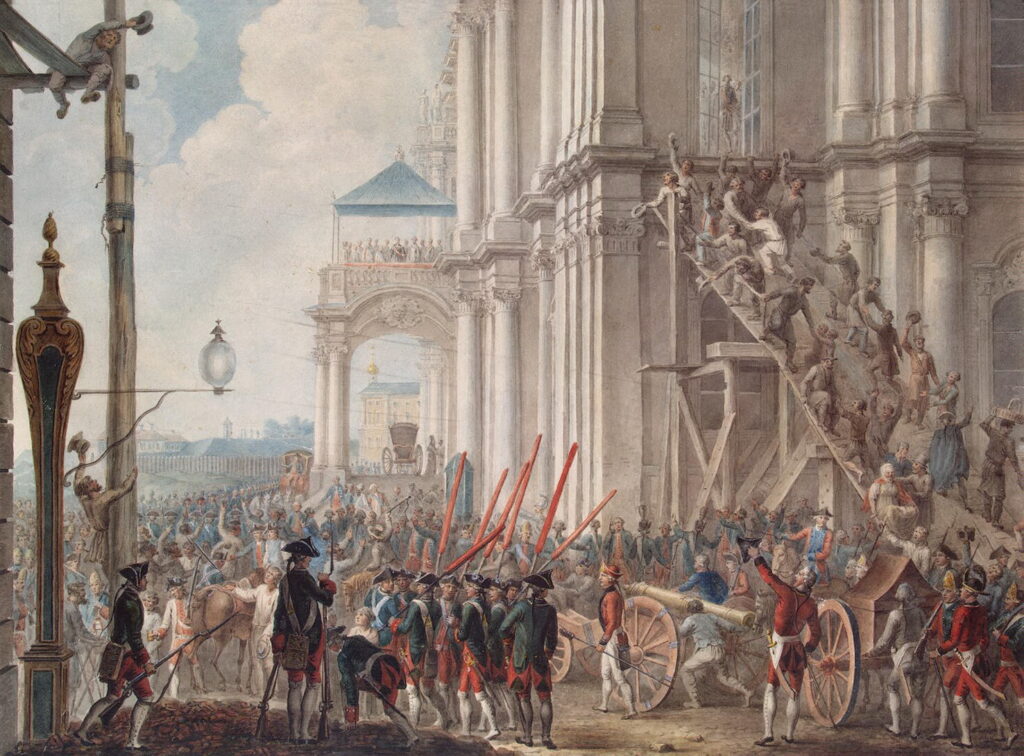
Two years later, in 1743, a letter landed in the hands of Catherine’s mother, Joanna.
From Empress Elizabeth, it invited Joanna to come and see Moscow along with her darling daughter. Shortly after, another letter arrived, this one from Frederick the Great, filled with subtle hints that the Prussian king could help Joanna marry her daughter off. Suddenly, it looked like Catherine was going to Russia.
For Joanna, this was the fairytale she’d been waiting for her whole married life.
She immediately set about spending the money Frederick had forwarded on fancy dresses and heaps of jewelry. Not for Catherine, but for herself. Joanna wanted to look her absolute best on the day she dumped her useless daughter on some unsuspecting Russian prince. By winter, 1743, Joanna and Catherine were on the road to St Petersburg.
If you’re wondering how Catherine felt about being whisked away to marry some dude she barely knew, the answer is that it didn’t matter. This was Europe in the 18th century. Arranged marriages were the norm in the upper classes. And, aged only 14, Catherine had grown into a very desirable bachelorette.
She was witty. Confident. Disarming.
Although she wasn’t a legendary beauty, she was already fighting off marriage proposals – not least from Joanna’s own brother.
Awkward.
Finally, after a very long, very cold journey, Catherine and Joanna arrived in Moscow. The imperial welcome they received was so big, so lavish that it left no-one in doubt about Catherine’s future role in the empire. Now all she had to do was actually meet Peter again after all these years.
A Match Made in Hell
If Catherine had grown up to be a charmer, Peter Ulrich had grown up to be the exact opposite; a miserable black hole that sucked all the joy out any room. The boy hated Russia. He hated Elizabeth, he hated Moscow, and he hated the fact he wasn’t in his beloved Prussia.
At first, the arrival of the German Catherine was a relief. Finally, someone who could understand his misery! But while Peter’s idea of a good time was writing fan letters to Frederick the Great and discussing how superior bratwurst was to borscht, Catherine’s was very different. From the moment she arrived in Russia, the teenage girl had fallen in love.
The Russia of the 1740s was a distant, mysterious place, almost entirely rural, with only a handful of cities.
The religion was not the Lutheranism Catherine had grown up with, but the exotic Orthodox rites of Eastern Christianity. For this girl from Germany, it was an alien land. A place of endless, fascinating contrasts.
And, much to Peter’s annoyance, Catherine was determined to fit in.
She began studying Russian, began her conversion to Orthodoxism. By the time she debuted at court on her 15th birthday, the upper classes were ready to love her. It helped that Catherine could be just as charming in Moscow as at home. She always had a killer quip ready, or a well-thought out compliment to disarm strangers with.
She even got a reputation for treating her servants as kindly as her upper crust friends, something of a big deal at the time. Before long, Elizabeth had bestowed the title Grand Duchess upon her, along with the name Catherine (or Yekaterina in Russian). But while the empress seemed to have made a good choice in Catherine, she’d made a much worse one in her heir.
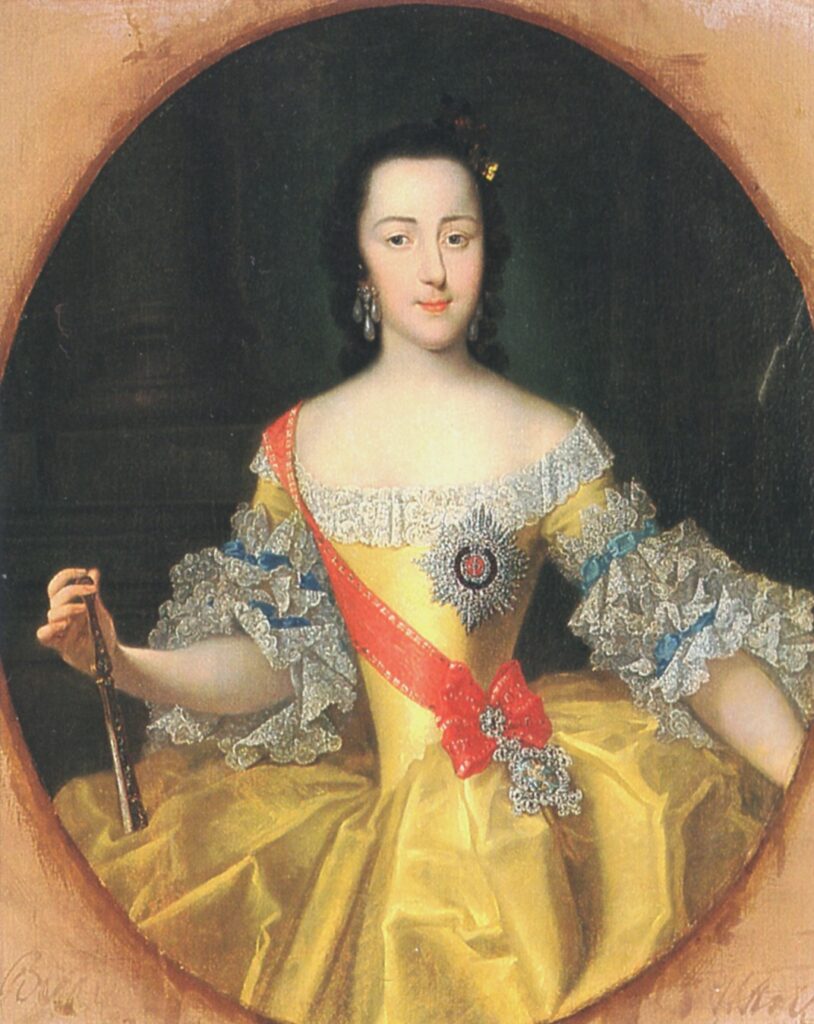
As Catherine grew more popular at court, Peter grew crueler towards her. He told her he was going to beat her once they were married, as that was the only way to control a woman. Started getting drunk and verbally abusing her. But as bad as Peter was already, he was about to get so much worse.
Not long before their wedding, Peter came down with a case of smallpox, a disfiguring disease we’d really advise against Googling. It took him six weeks to recover. When he finally did, his face was so scarred that Catherine couldn’t bring herself to look at him. Bitter, angry, and miserable, Peter retreated from the world, locking himself in his rooms and refusing to do anything but dress his servants in Prussian army uniforms and play soldiers. He only really emerged for the lavish wedding on August 21, 1745. But even then, his bitterness got the better of him.
Early in the evening, Catherine was sent by Elizabeth to the marital bed to await Peter and get on with the job of producing heirs. Instead, Catherine lay there for hours in the dark, waiting for her new husband. When Peter finally turned up, he was so drunk he simply collapsed. Not a word. Not a kiss. Not even a joke. Just one unhappy teenager passed out on the floor, and another unhappy teen likely wondering if this marriage had ruined her life.
Well, if Catherine ever did wonder that, she was wrong. As toxic as her marriage was, it would wind up making her into a figure remembered by history.
She just had to survive the next few years first.
Intimacy and Intrigue
By late 1745, Elizabeth’s enthusiasm for Catherine had distinctly cooled. There still hadn’t been any royal heirs, so Elizabeth wrote Catherine a stern note reminding her she better get knocked up fast. But there was very little Catherine could do about it. By now, Peter was actively avoiding sex, preferring to play with his toy soldiers and live in a fantasy world.
One evening Catherine came into their room to find him putting a rat he’d caught on trial. When she asked him what he was doing, he declared the rat guilty and sliced off its head. In the wake of this incident it’s perhaps not surprising that Catherine started an affair.
Today, Catherine’s affairs are legendary.
But we’ll come to all that. For now, just know she started sleeping with a guy called Sergei Saltykov, possibly in an attempt to get pregnant, and possibly with Peter’s knowledge. Yet, try as she might, Catherine just couldn’t become the baby-producing machine Elizabeth wanted her to be. Oh, she got pregnant all right. Multiple times. But she always miscarried.
Before anyone knew what was happening, nine years had passed, and Catherine was still not a mother. That finally changed on October 1, 1754.
That day, baby Paul was born at the end of a labor best described as “arduous.”
The moment the baby was out, Elizabeth came in and snatched it away to raise herself. Catherine, for her part, was left lying alone in her own blood for hours, too weak to move. With her heir-producing duties now over, Catherine entered a new, depressing stage in her life at the Russian court. Now the baby was here, everyone just started ignoring her. They held a party to celebrate Paul’s birth while Catherine was still convalescing.
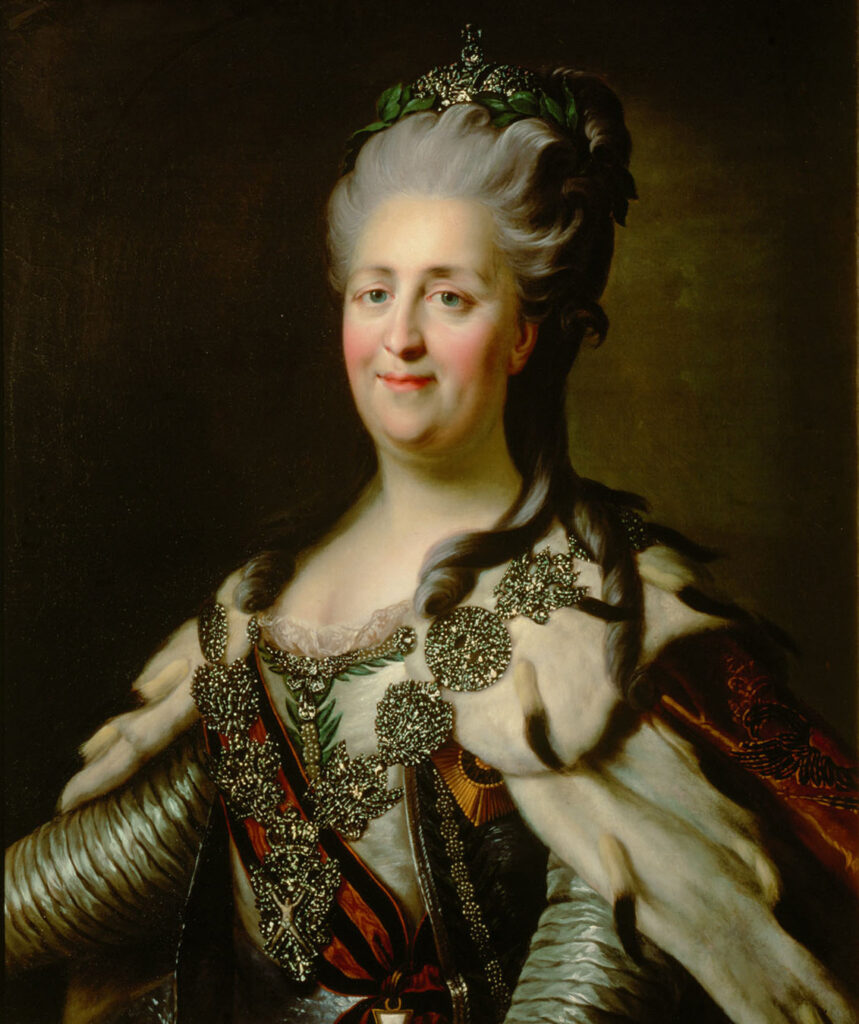
All she got was a drunk Peter sticking his head in the door and muttering something like “err, well done,” before going back to the party. Had Catherine been another woman, it’s possible her story would’ve ended here, finally beaten down by her awful new family. But this is Catherine we’re talking about. A woman who has “the Great” in her name.
Rather than give up, she spent her convalescence reading Voltaire and plotting her return to court. On Peter’s birthday, she finally managed it. Kitted out in the finest regalia, Catherine crashed the party, inviting herself in unannounced and restyling herself “mother of the heir”. With breathtaking confidence, she casually snubbed those who’d ignored her after her labor. Dropped deliciously poisonous witticisms about anyone who tried to stand up to her.
From that point on, Catherine would never let herself get isolated again.
She cozied up to the British ambassador, accepting bribes in return for information, bribes she used to buy herself a network of informants. As the 1750s swept by, Catherine began buttering up people in positions of power. Leaders of army units, aristocrats, anyone who might one day be useful. By the end of the decade, she’d even taken two important lovers: Stanisław Poniatowski, the future king of Poland, and Grigory Orlov, the man who’d make her empress.
But, powerful as she now was, Catherine was still vulnerable.
When she gave birth to her second child, Anna, Peter came and watched the whole thing, drunk out his skull, declaring that he could do anything to her. It must’ve been a chilling thing to hear. It also steeled Catherine’s resolve. If she ever wanted peace, she was going to have to get rid of her husband once and for all.
The Battle for Power
In 1756, a war broke out that engulfed half the world. Known as the Seven Years’ War it involved most of the European powers, including pitting Russia against Prussia But bad as the Seven Years’ War was, it was nothing compared to the battle brewing in the Russian court. By 1762, Peter had begun a public affair with Elizaveta Vorontsova, a coarse woman of coarser manners.
On top of that, he was parading around wearing Prussian uniforms and telling everyone they shouldn’t be fighting Frederick the Great.
He was even promising Catherine that, as soon as he became emperor, he would have her shaved bald and thrown in a convent. It was a threat that was about to become very real. On January 5, 1762, Empress Elizabeth breathed her last. In the wake of her death, Peter was elevated to the throne as Peter III. One of his first acts was to spend Elizabeth’s funeral procession openly celebrating her death.
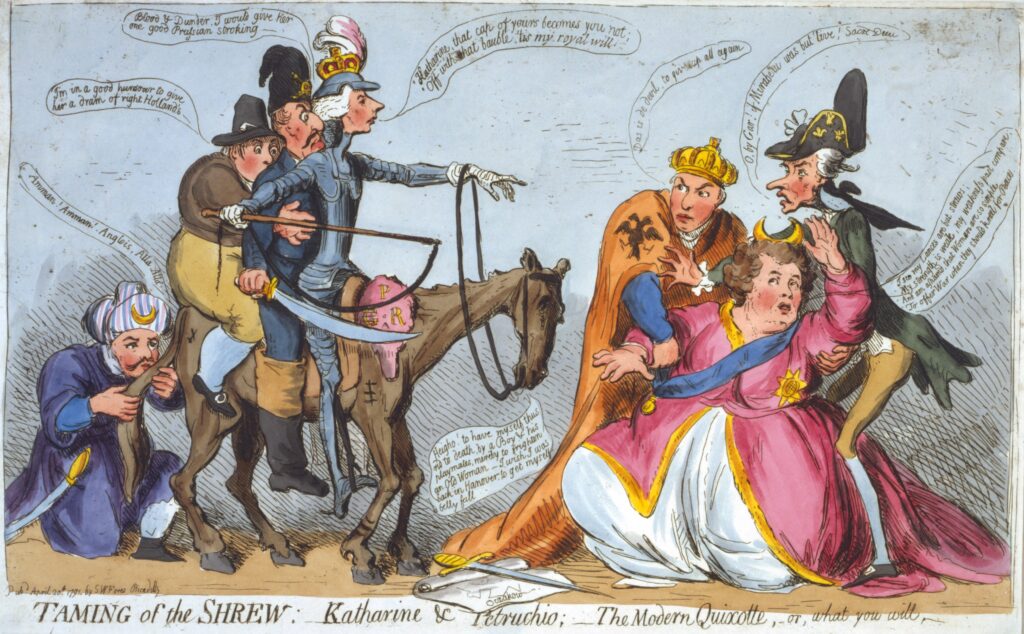
His second act was to make his popular, unwanted wife suffer. In the months that followed, Peter III began inflicting humiliation after humiliation on Catherine. He forced her to personally award medals to his mistress Elizaveta, dragged her out in public and tried to make her confess that their son Paul was illegitimate.
But it wasn’t just Catherine Peter was getting his vengeance on.
For so long, he’d hated Russia. And now he was in charge, he was going to dismantle the whole damn country. Church property was stripped and given to Lutheran ministeries. Army units were forced to drink toasts to Frederick the Great. Everything became pro-Prussian, anti-Russian, and very anti-Catherine. For Catherine, those months must’ve been a nightmare.
Luckily, she was about to wake up. That summer, July 8, Catherine’s lover Grigory Orlov abruptly came to her and basically said “let’s throw this asshole over. Right now.”
And so they did.
The coup was organized by Orlov with the help of his brothers and a guy called Grigory Potemkin, who we’re gonna come back to soon. It was simple and bloodless. Dressed in a male uniform, Catherine rode out to meet army units loyal to her. As they joined, more declared their loyalty, until it was clear no-one in Moscow stood against her. Finally, on July 9, 1762, Catherine was declared Empress Catherine II. And that was that.
Well, almost.
Just outside Moscow, Peter was drilling some of his troops when word came in of the coup. But it wasn’t just news that was traveling in Peter’s direction. Catherine was riding out at the head of an army. So Peter did the only thing he could: he abdicated and threw himself on his wife’s mercy. Apparently, he hoped to be sent into exile in Prussia. But Catherine was all like “nah,” and had him placed under house arrest.
8 days later, Peter was dead.
The historical record isn’t clear on what killed poor, damaged Peter Ulrich. Officially, it was a nasty bout of hemorrhoids. Unofficially, it’s thought he was strangled on the orders of Orlov. Whatever the truth, the result was the same. On September 22, 1762, Catherine was crowned empress of Russia in a lavish ceremony at the Kremlin. The anonymous girl from Germany had finally done it. She’d survived the intrigues of the Russian court, survived her marriage to a madman, and smashed through the glass ceiling as effectively as a tomahawk missile.
Now came the hard part.
An Instruction for Change
In 1767, Catherine sent her legislative committee a simple Instruction. Known as the Instruction of Catherine the Great, it set out her vision for the future. Under her watch, Russia would conform to the ideals of the Enlightenment. Things like innocent until proven guilty would become law. The common good would be emphasized. The country’s 8 million serfs would be considered people.
To our ears, this can sound a little “well, duh.”
But in 18th Century Russia it was a bombshell. Even other European powers were aghast. France actually banned copies of the Instruction to avoid a revolution. Yeah, good luck with that. But while Catherine’s ideas were revolutionary, her implementation of them was not. Rather than act like good little Enlightenment thinkers, her committee fell to squabbling. Then war broke out and the whole idea was completely forgotten.
The Russo-Turkish War decimated Catherine’s domestic agenda between 1768 and 1774, but at least it shored up her power, helped by the capture of Crimea. Still, by the time the dust had settled, Catherine was 12 years into her rule and had accomplished only a fraction of what she wanted to do. So she dropped any pretence of governing by committee. From now on, she was going to force her reforms through by personal decree.
And what reforms they were.
Catherine opened the first schools for orphans, the first hospitals for the destitute. She encouraged girls into education, at a time when most households valued women somewhere below horses and about equal with good footwear. City governments were reformed to better serve the people. The police were transformed from an instrument for repression into one that at least nominally helped ordinary folk.
Then there were the great cities Catherine built, like the port of Odessa, where skilled immigrants were invited in to transform the economy. She even undertook the first detailed mapping of Russia. There’s a great story that Catherine was in a meeting where a far-flung town was discussed. When Catherine asked where it was, all her advisors shrugged. So she sent someone out to buy a map. When they came back, she discovered that not even the map makers had bothered to map most of Russia.
You better believe that changed pretty sharpish.
But while Catherine’s reforms brought Russia into line with its European neighbors, they weren’t all successful. Remember how her Instruction called for the country’s 8 million serfs to be considered people?
Those serfs were basically slaves, tied to the land and owned by local landlords. When Catherine realized her core support came from those same landlords, she did an about face and actually increased serfdom.
This touches on the other issue of who benefited from Catherine’s reforms.
We mentioned earlier that 18th Century Russia was about 95% rural. Yet the vast majority of Catherine’s reforms were in urban areas. As transformative as her domestic agenda was, millions of Russians didn’t even realize it was happening. Still, her reforms got her noticed abroad, where people like Voltaire championed her as a great philosopher empress.
But Catherine’s reputation would soon become international news again for a very different reason.
It’s time to talk about sex.
Love & Death
So far in this video, we’ve met three of Catherine’s lovers: the guy who possibly fathered Paul; the guy who became King of Poland; and Orlov, the guy who probably strangled Peter III. Now it’s time to meet the most-famous of them all. Grigory Potemkin had been a background character in Catherine’s life for decades. He’d helped Orlov organize the coup that overthrew Peter III. In the Russo-Turkish War, he’d been the one who secured Crimea.
And now he was back in the imperial court, determined to charm his way into power.
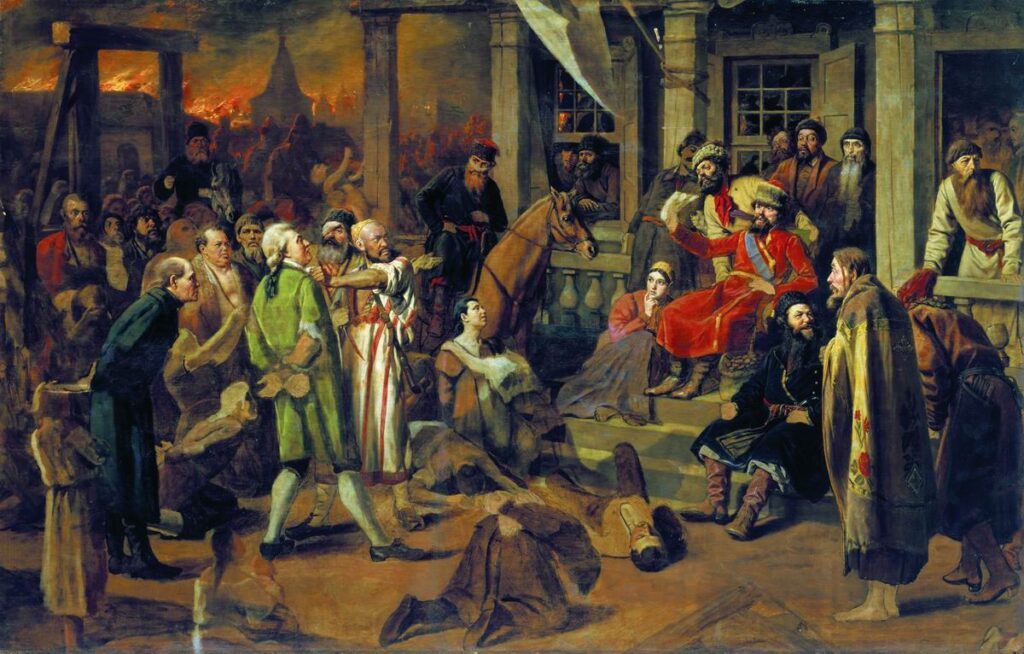
To say Catherine and Potemkin were suited to one another is to miss just how perfectly they matched. Potemkin was ambitious, fearless. Not exactly handsome, but attractive in a “this guy does not give two flying flips” sort of way. His ambition also complemented Catherine’s. While Catherine was happy to lose herself in details, Potemkin was a big picture thinker, able to spur her dreams to greater heights. Catherine summoned him to court in 1774. Before the year was out, they were lovers.
There’s even some evidence to suggest they married in a secret ceremony, inside a tiny, backwater church with only two witnesses.
It’s certainly true she named him Prince Potemkin, and elevated him to a status nearly equal to co-ruler. But while their burning ambition is what brought Catherine and Potemkin together, it was also what killed their love. By 1780, both were fully aware that their love of power was corrupting their romantic relationship. So they made a deal.
From now on, Potemkin would remain as Catherine’s political advisor. But in the bedroom, he would be replaced – not with another ambitious, powerful man, but with a string of anonymous studs. And so we come to the one thing about Catherine the Great that everyone remembers: her sexual escapades.
The fact this is monstrously unfair goes without saying.
Catherine’s contemporary, Louis XV, had so many mistresses he could give Prince a run for his money. Selim III had an actual harem. But, of course, it’s the highly-sexed woman who goes down in history as using a horse to satisfy herself, as story as fake now as it was then.
Stay classy, 18th Century propagandists.
Still, there’s no denying that Catherine’s reputation abroad really did take a beating in the back end of her reign, and not just because of ill-founded sex rumors. In 1789, that revolution France had been trying to avoid finally broke out, based on a lot of those same Enlightenment ideals Catherine professed to love. But now that those ideals were questioning the divine right of monarchs, Catherine was suddenly all like “What Enlightenment? Voltaire? Never heard of him.”
When Poland began agitating for a French-style liberal constitution in 1792, she forced the Second Partition on the kingdom, dividing most of it up between herself, Austria, and Prussia. When Tadeusz Kościuszko led a rebellion against the partition two years later, Catherine cracked down as hard as any tyrant. In Warsaw, some 20,000 Poles were executed in a single day – more people than died during the entire Reign of Terror. By the time Catherine instigated the Third Partition of Poland in 1795, wiping the nation off the map, her Enlightenment credentials had been reduced to a hollow punchline.
But by then it barely mattered.
Grigory Potemkin had died in 1791, leaving Catherine isolated and lonely. In his place, the empress had begun to devote all her attention to her grandson Alexander, even hinting that she would pass her son Paul over for succession. Naturally, this created a deep rift in the imperial family, and left Paul eager to get one over on his mother.
On November 5, 1796, Catherine was found on the floor of her bathroom, almost carried off by a stroke. The very next day she died, her grandson Alexander still too young to take over from her. In his place, Paul I ascended to the throne. And he quickly set about trashing his mother’s legacy.
The first thing he did was have all her papers burned, just in case she’d written him out her will.
Then he had poor Peter Ulrich dug back up and given the state funeral Catherine had denied him. Finally, he ordered his mother buried alongside his father. After spending the early part of their lives entwined in a toxic marriage, Catherine would now spend eternity alongside her hated husband, too. At the moment of her death, Catherine must’ve wondered how history would remember her.
Sure, she’d expanded Russian territory, adding around 520,000 square kilometers.
Sure, she’d brought in liberal reforms and modernized urban Russia. But, at the same time, she’d failed in her goal to abolish serfdom, just as she’d failed to institute reforms that improved life for the 95% of the population who lived outside the cities.
So why, then, do we remember her as Catherine the Great?
Well, from our modern perspective, it’s easy to see why. Just listen to her life story: a provincial girl who overcame a parental neglect, a forced marriage and an abusive husband to become one of the most powerful women in Europe. But even in the 18th Century, it was clear that Catherine was someone special.
With her liberal reforms, she opened the door for a Russia that existed to help its citizens, not brutalize them. While that door would be slammed shut again by successive regimes, knowledge of what lay behind it never really went away.
All those utopian revolutionaries. All those moments of thaw in the 20th Century. Those shuddering moves towards openness in the 1980s. All were distant descendants of Catherine’s attempts to mould her country in a kinder image. She may not have always succeeded in her goals, but Catherine deserves to be remembered by her title.
She really was the greatest empress in Russian history.
Sources
Excellent two-part podcast on her life: http://thehistorychicks.com/episode-61-catherine-the-great-part-one/
http://thehistorychicks.com/episode-63-catherine-the-great-part-two/
Excellent BBC Podcast: https://www.bbc.co.uk/programmes/p003hycx
Britannica biography: https://www.britannica.com/biography/Catherine-the-Great
Detail on the legislative committee (aka Instruction of Catherine the Great): https://www.britannica.com/event/Instruction-of-Catherine-the-Great



